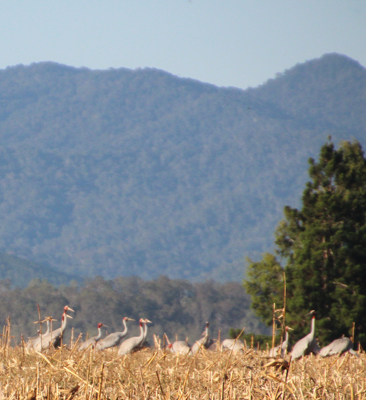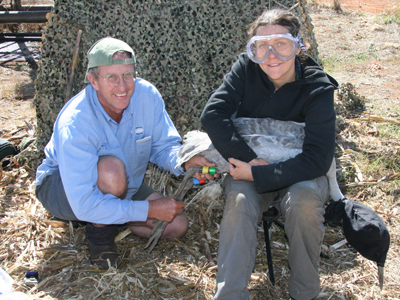
By Dr. George Archibald, ICF Co-founder & Senior Conservationist
A week with the Sarus in Australia
Forty-two years have rapidly passed since I enjoyed two months on Queensland’s Atherton Tablelands with Sarus Cranes, Brolgas and a new crane I discovered, the Sarolga (a hybrid). This October, crane country looked much the same, but the town of Atherton had tripled in size, and Sarus had increased from about 150 to more than a thousand. Three close friends had passed away, and two others had left the area. So I made new friends.
At about 3,000 feet above sea level, the Tablelands are a plateau measuring about 100 km x 60 km and running north-south between the eroded remains of ancient mountains. The Pacific-facing slopes of the eastern ridge that catch the rain are carpeted by dense rainforest rife with cassowary and tree kangaroo, while the western slopes of the west range face the droughts of the Outback. Cradled between the ridges, 150 years ago, the Tablelands were a complex of forests and savannas – home to Njadjon, Yalanji, Muluridji, Barbaram, Jirrabal, Djabugai and Mamu people. Then the moderate weather of higher altitudes and fertile volcanic soils attracted white settlers. The forest on the Tablelands floor were harvested, and replaced by farms where Sarus, a crane formerly known from south Asia, were first recognized in Australia in the early 1960s.
Photo: Above, harvested corn fields provide an abundance of gleanings for Sarus Cranes. Tropical forest, in the background, once covered the Atherton Tableland. As in many parts of the world, cranes are benefiting from agriculture.
My host was distinguished conservationist and now budding researcher, Tim Nevard; who, following a successful international career in business, has retired to his family home on the Tablelands, to embark on a study of cranes as the topic for a doctoral dissertation with Charles Darwin University, Australia. As a member of Tim’s Graduate Committee, I dropped into my old stomping grounds both to learn and to encourage.
It was a thrill to experience dawn from a hide in a harvested corn field heralded by the songs of magpies and bush stone curlews, to see three species of kites cruising the fields for rodents, and then to have enormous hungry cranes landing nearby to feed on gleanings. Sunrise was matched with grandeur at sunset, as we stood near the flight path of hundreds of cranes returning to roosting areas of shallow water.
 Tim is gathering evidence that progressive agricultural shifts on the Tablelands from rice, corn and peanuts, to fruit trees and sugar cane, may be reducing food available for cranes. To encourage the local people’s interest in the welfare of the cranes, Tim’s gifted wife Gwyneth and the Board of the Wildlife Conservancy of Tropical Queensland (WCTQ) organized Australia’s first Crane Week, at which I spoke about challenges cranes face worldwide and what might be done to assure their welfare during dry season on the Tablelands.
Tim is gathering evidence that progressive agricultural shifts on the Tablelands from rice, corn and peanuts, to fruit trees and sugar cane, may be reducing food available for cranes. To encourage the local people’s interest in the welfare of the cranes, Tim’s gifted wife Gwyneth and the Board of the Wildlife Conservancy of Tropical Queensland (WCTQ) organized Australia’s first Crane Week, at which I spoke about challenges cranes face worldwide and what might be done to assure their welfare during dry season on the Tablelands.
Photo: Right, Tim Nevard and research assistant, Jess Harris, place color bands on a Brolga, as part of Tim’s research into the interactions between Sarus and Brolgas on the Atherton Tablelands and Gulf of Carpentaria in Australia. Photo by WCTQ
Across the seas to the northwest, circa 1,000 Eastern Sarus that grace the wetlands of Cambodia and Vietnam are also threatened by habitat loss in nations teeming with millions of people (learn more about ICF’s work in the Mekong River basin). It’s comforting that the Australian Sarus are relatively safe and increasing. Dedicated colleagues in Southeast Asia and the Nevards in Queensland will undoubtedly help the cranes survive the changes.
